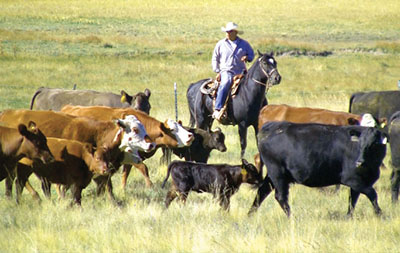Guide B-224
Revised by John Wenzel
College of Agricultural, Consumer and Environmental Sciences, New Mexico State University
Author: Extension Veterinarian, Department of Extension Animal Sciences and Natural Resources, New Mexico State University. (Print Friendly PDF)
For information about calf vaccination programs, see NMSU Extension Guide B-223, Calf Vaccination Guidelines (https://pubs.nmsu.edu/_b/B223/index).
Introduction
Cow herd vaccination programs, like calf vaccination programs2, are an important component of a complete herd health program. The immune response depends on proper nutrition, vitamin and mineral balance, and proper preparation of the immune response beginning when the cow is a newborn calf. Vaccination protocols should be designed with specific management systems and production goals in mind. Consult your herd veterinarian to assist you in developing a complete herd health program.
Preventing Disease in the Cow and Passing Immunity to Calves
Some cow vaccinations, such as blackleg (clostridials) or lepto, are given to protect the cow from diseases that affect her directly. Some cow vaccines are given to help prevent diseases that can result in a loss of pregnancy, either from making the cow sick or making the unborn calf sick, thus helping prevent abortion. Examples of diseases these vaccines protect against are viral diseases like infectious bovine rhinotracheitis (IBR) and bovine viral diarrhea (BVD), bacterial diseases like vibriosis (bovine venereal campylobacteriosis) and leptospirosis, and protozoal diseases like neospora and trichomoniasis. Some vaccines develop immunity in the cow that is passed in the colostrum so her unborn calf will be protected from certain diseases, for example rotavirus, coronavirus, or Escherichia coli (E. coli), agents that cause scours in newborn calves. The timing of scour vaccines is very important and must follow label directions. In New Mexico, most pregnancy losses occur between mid-December and mid-February. Therefore, it may be preferable to vaccinate cows in the fall when cows are gathered for pregnancy testing so the immunity stimulated by the vaccination will peak just before the greatest disease challenge and stress level to the pregnancy. In the fall, cows are generally in the best body condition of the production year, so malnutrition is less likely to affect cows’ response to vaccination.
Colostral immunity that is transferred to the calf in colostrum is very important for the protection of the calf and in the development of that calf’s acquired immune response. Failure to receive an adequate volume of good-quality colostrum (called failure of passive transfer) will affect the immune response of that calf for its entire life. The preparation of the dam’s immune response is directly related to the quality of the colostrum she will pass along to her calf. The dam’s nutritional, mineral and vitamin, and vaccination status will also affect the quality of colostrum she produces.
Vaccination Protocols
If cows are on a spring vaccination (fall calving) schedule, modifications to the fall vaccination program shown here may be needed. It is important to note that there is a wide variety of vaccine types, combinations, and uses. Have your local veterinarian assist you with product selection and protocols. Labeled directions must be strictly followed because some vaccines have narrow parameters of efficacy. For example, trichomoniasis vaccine must be given just before the breeding season because the duration of immunity from vaccination is very short. If this vaccine is administered at a different time, its efficacy may be compromised. It is also important to include bulls in the cow herd vaccination program because they can be a reservoir for many diseases that can contribute to pregnancy loss.
The following is an example of a vaccination protocol for a spring calving cow herd given at fall preg check:
Cows and bulls
Viral vaccine for IBR, BVD, PI3, BRSV:
- Chemically altered (CA) vaccines (preferably those labeled for fetal protection). OR
- Modified-live virus (MLV) vaccine following a protocol that is labeled for use in bred cows under strict adherence to label directions. OR
- Killed vaccines can be used, but the immune response will not be as robust, especially if the cows were not “primed” using MLV vaccines prior to breeding.
Bacterial vaccines:
- Long-acting Campylobacter fetus (vibrio)/leptospirosis (lepto) vaccine
- 7-way clostridial booster (optional)
- Dewormer
- Other vaccines if necessary in your area
NOTE: In the fall, bred replacement heifers should be vaccinated using the same protocol as the mature cows.
Replacement heifers (branding to pre-breeding)
- Branding (at 2–4 months of age):
THEN
- Pre-weaning and/or weaning:
- Pre-breeding:
For Further Reading
B-222: Cattle Vaccination and Immunity
https://pubs.nmsu.edu/_b/B222/
B-223: Calf Vaccination Guidelines
https://pubs.nmsu.edu/_b/B223/
B-226: Increasing the Effectiveness of Modified-live Vaccines
https://pubs.nmsu.edu/_b/B-226/
Original authors: John Wenzel, Extension Veterinarian; Clay P. Mathis, Extension Livestock Specialist; and Boone Carter, Extension Associate.
John C. Wenzel is the Extension Veterinarian in the Department of Extension Animal Sciences and Natural Resources at NMSU. He earned his B.S. from NMSU and his DVM from Kansas State University College of Veterinary Medicine. His work focuses on cow/calf medicine and preventive health programs for livestock producers in southwestern New Mexico.
To find more resources for your business, home, or family, visit the College of Agricultural, Consumer and Environmental Sciences on the World Wide Web at pubs.nmsu.edu
Contents of publications may be freely reproduced for educational purposes. All other rights reserved. For permission to use publications for other purposes, contact pubs@nmsu.edu or the authors listed on the publication.
New Mexico State University is an equal opportunity/affirmative action employer and educator. NMSU and the U.S. Department of Agriculture cooperating.
Revised February 2023 Las Cruces, NM




